The Art of Shaping: Exploring the World of Injection Molders
In the world of manufacturing, injection molder s play a vital role in shaping a wide range of products we use in our daily lives. These machines are the unsung heroes behind the scenes, working diligently to produce everything from intricate plastic components to household items with precision and efficiency.
Injection molders are versatile tools that use a process called injection molding to create parts by injecting molten material into a mold cavity. This process allows for the mass production of complex shapes and designs with high accuracy and consistency. Whether it's automotive components, medical devices, or consumer goods, injection molders are at the heart of bringing ideas to life in the form of tangible products.
History of Injection Molding
Firstly, injection molding traces its origins back to the late 19th century when the first patent for a basic injection molding machine was filed. Over the decades, advancements in material sciences and engineering have transformed injection molding into a sophisticated manufacturing process that underpins various industries today.
As technology progressed, injection molding gained traction in the mid-20th century as a cost-effective and efficient method for producing intricate plastic components at scale. This innovation revolutionized the production landscape, enabling mass production of products ranging from toys and consumer goods to automotive parts and medical devices.
Today, injection molding stands as a cornerstone of modern manufacturing processes, offering unparalleled precision and versatility in shaping a wide array of materials. The continuous refinement and adoption of cutting-edge technologies have further solidified injection molding's position as a pivotal technique in creating high-quality, complex components across diverse industries.
Types of Injection Molding Processes
Injection molding processes can vary based on the specific needs of the project. One common type is conventional injection molding, ideal for mass production with high precision and repeatability. This process involves injecting molten material into a mold cavity where it cools and solidifies to form the desired shape.

Another type is insert molding, where inserts such as metal components are placed into the mold before the injection process. This allows for the creation of complex parts with varying materials or components integrated seamlessly. Overmolding is also a popular technique, involving the molding of multiple materials onto a substrate in layers, creating durable and versatile products.
Benefits of Injection Molding
Injection molding offers numerous advantages. First, it enables the production of intricate and complex shapes with high precision. This method allows for the creation of detailed features that may be challenging to achieve with other manufacturing processes.
Secondly, injection molding is a cost-effective solution for large-scale production. Once the initial tooling is set up, the per-unit cost decreases significantly, making it an efficient choice for mass production of plastic components.
Furthermore, injection molding is a highly efficient process with minimal waste. The materials used are usually thermoplastics, which can be melted and reprocessed. This reusability reduces material wastage and contributes to a more sustainable manufacturing approach.